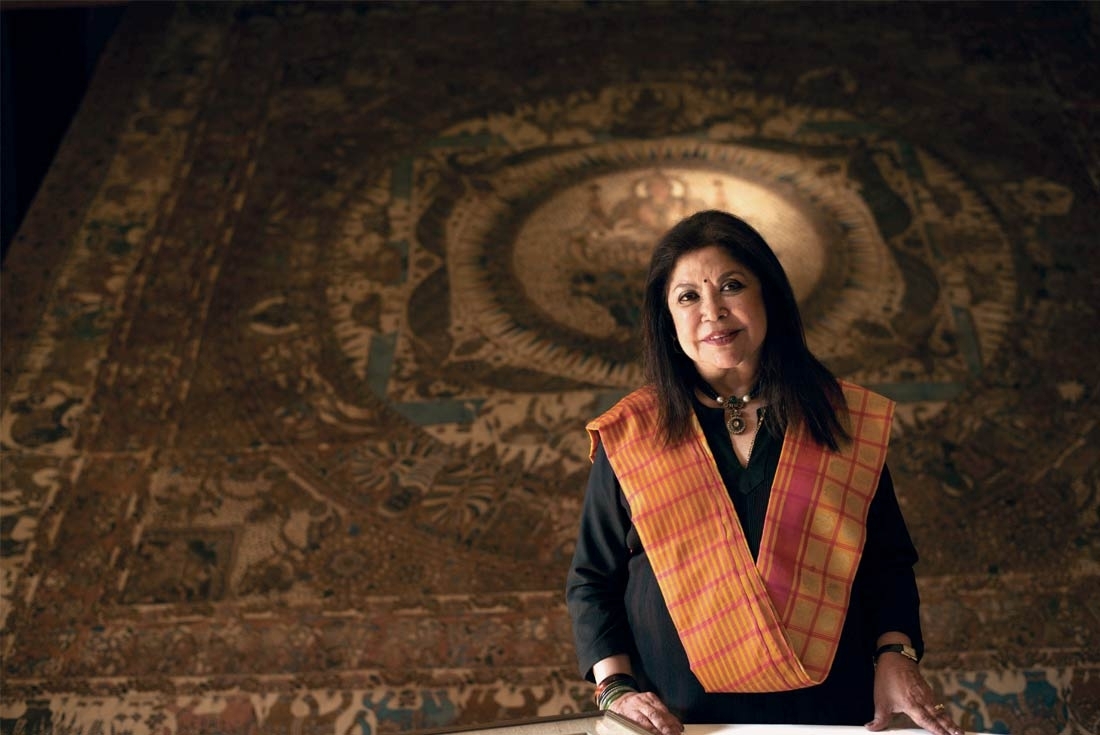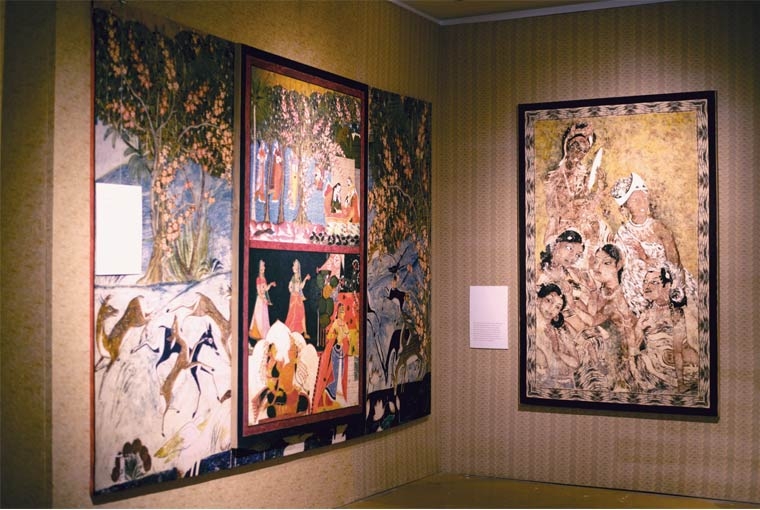
Photography Sharad Shrivastav

Photography Sharad Shrivastav
We revisit our interview with veteran designer Ritu Kumar as her label marks its sustainable comeback with Lenzing's EcoVero at Lakmé Fashion Week.
I am sitting in the corner, studying the pages of the first part of her new 12-part series of travel memoirs, Crossroads, and journeying along the rich roads of Tashkent even as she films for her daughter-in-law, Christina, at the other end of the room. The accounts are vivid, moving, enlightening, immersive— it is much more than a journey in textile and design. It is her life in motion through 50 years of travelling through South Asia and Europe. Part professional memoirs, part musings of an art enthusiast, part personal reflections on the historical regions that she has visited— the publications form, perhaps, the only known contemporary form of travelogues authored by a designer in post independent India. Lest I get lost too deep, I’m called out for; she wants to walk me along so I can listen to what she is saying to the camera before we sit down to hear her out on the rest of the journey. The artist who gave India her classical style back as a matchless contemporary statement, a design scholar who studied tradition and textile through the world and decades, and a creator who has never thought of herself as a ‘fashion designer’—Ritu Kumar is a treasurehouse brimming with rich insight. Platform picked up a few pearls…
Congratulations on the golden jubilee! With the first in your 12-part Crossroads series now out, how do you plan to roll out the other 11 travelogues?
Most of them are written, and the expression has helped me enormously. The first book is about Uzbekistan, and the next is about Bengal. I’ve lived there for a large part of my life. It has been interesting to identify the imagery that should go into the books in those particular chapters. There are some pattachitras, collages, Kalighat references and of course the text to which I would put faces from Bengal that shaped my journey. Each of these memoirs—based on my travels through Bengal, Kashmir, Benaras, Bhutan and Burma, Tamil Nadu and Masulipatnam, Goa, Maharashtra, Gujarat and Rajasthan—would be like the Uzbekistan chapter. For Uzbekistan, there was an exhibition with snippets narrated through diary entries, memorabilia, vintage textiles, collages and paintings and other visual elements which which were carefully curated by Mayank Mansingh Kaul. But not all the other memoirs will see similar exhibitions.
Going back, do you remember your first connect with design or textile?
The first time I felt deeply connected was in Serampur, West Bengal. This was in the late 60s, when I was in my 20s. I found this village with absolutely no work, and blocks lying around like papers, and they had pretty work, beautiful designs, but where was the printing? It was all clean because the British put such heavy levies on them— taking these designs, printing them in Liverpool and bringing these back to India to sell them here made me very angry! That is when the first instinct came—I thought I should really try and do something about it because I could paint, I could put together things for them.
I was an art student, and I realised there was very little disconnect between textile and sculpture in India. When you see the temples, you have the same elephants on sculptures, and on saris. It is not like Europe where this is not true. I knew very little about this at first. I went out and studied at V&A in London because in India we had no resources back then and I found them printing our designs in France. That’s when I saw that the paisley was the biggest copyright infringement we have had in our country and everything was taken from India! Therefore the history of the subject also started to interest me.
What made you document all your travels and experiences?
It started with documenting hand-block printing, which is gone now. I wondered why it was not being used anymore, and then I realised that no one had put down a history of printing in India, one of the most influential fashion statements that the world has got from the country—and we don’t have a documented history! But I did not want to write a clinical or technical history. I wanted something that made sense to people and urged them to take their own journeys, so details like where to go and what to eat were important. Then I started writing a travelogue for wherever I went. I had these reams of notebooks. You see, while you’re in the flight or car you have two hours, and sometimes you just sit and write about how many mango trees are around!

A lot of your design sensibility has remained consistent through 50 years of your practice. What would you attribute this to?
Perhaps it is the consistency of the set of textiles that I’m working with. Except for the Kutch tradition which has a folk character, the rest of the traditions have a classical norm and are very highly technical and sophisticated in their usage, technology and their colour. It is about the consistency in the quality and tradition that it all belongs to. Fashion was never really my beat, the fact that fabrics become fashion is another story. I see to a large extent that my future work will go more into this area rather than being just ‘fashion design’.
What is the biggest challenge that you have faced?
The biggest challenge, and I don’t blame anyone for it even as I’ve been a victim of it, is that we are very insecure about ourselves. There’s such a huge colonial baggage on our back that anything that was Indian was inferior and anything that was western was superior because they have very, very powerful media and deep pockets. They had a 100-year headstart on us so just to break that mindset has always been a challenge.
I think we have come a long way and I hope tomorrow we are not going to be talking about eastern or western. I think we are going to be talking about aesthetics. And that’s where our textile will score.

What inspires you?
The female ideal in Indian history and how distorted it is, or how non familiar it is with what we are told today. What do our pictures from 1000- 2000 years in the past say? Women have big bottoms, big bosoms, they’ve got little waists and flowers in their hair. What are they saying? This is what we are all about. India was never like this. So we have gone a long way in making ourselves unhappy and there is absolutely no need for us to feel that way! It is brainwashing to a large extent. I want to understand more about when it started, how it happened. There is very little evidence of what the women in India were like at the time and if they were painted, I found them in little pockets like the Jain Sutra manuscripts in Orissa and I had to really search to put a collage together because it isn’t archived in any one space. What happens when you release the Shakti—or Kali—that
created such a strong movement...I’d like to write about those things. The Indial female ideal always inspires me and there is a bigger story to tell therein; our women have been far more progressive than in other parts of the world.
What is next?
I wish and I hope that this activates people to go out into the thicket. There are so many places in India to still explore and we have very young, modern and dynamic fashion designers who I’d like to show the way if they want. Our travels should not only be to certain hill stations. This country is as rich as it is; I used to feel so bad for people not having had the experience…I had a much-enriched life thanks to travel. I’ve touched a lot of lives, a lot of people have touched my life; I’ve met such a wide range of people and seen such a wide range of craft and lifestyles. It has always been, for me, taking the road less travelled. I think crafts people are motivated by different things at different times. A lot of times, part of the craft goes into Bhakti—temple worship to the gods, and part of it for commerce. I think this is what differentiates us; I don’t think that if we would have only got polka dots from America and sold it on scarves it would have lasted that long. There is some other involvement, especially spiritually, when I observe what they do in these areas—particularly weaving, like in Benaras. If you hear about Kabir, he always saw his craft as weaving cloth for the gods. Because he was creating. And these weavers were singers and poets; there used to be a parallel stream. So when you visit these areas, it is a completely different world from sitting in a metropolis—your whole existence gets enriched. I hope to be able to make a difference through that larger experience.
This article is a part of the From the Archive series where we revisit relevant articles from our substantial article archive.
Text Soumya Mukerji